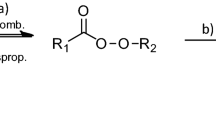Abstract
Oxidative induction time (OIT), constant temperature stability (CTS) and isothermal crystallization are examples of isothermal time-to-event (TTE) measurements obtained using differential scanning calorimetry. In TTE experiments, a test specimen is heated/cooled at a constant rate from the setup temperature to an isothermal test temperature. Once the test temperature is achieved, a clock is started and the time to the thermal event (e.g., onset to oxidation, thermal decomposition or crystallization exotherm peak) is measured. Such TTE values may be used to rank stability of the material at the test temperature. Some portion of the reaction of interest, however, takes place during the pre-isothermal period as the test specimen approaches the test temperature. This amount of reaction is unmeasured and represents a bias in the resultant TTE value. An equation has been derived and numerically integrated to estimate this bias. This approach shows that the bias is dependent upon the activation energy of the test reaction, the heating/cooling rate used and the temperature range between the melting temperature and the test temperature. For commonly used heating rates, the bias for OIT and CTS tests is small. Further, the myth that isothermal crystallization kinetics determinations required high cooling rates is dispelled with the bias of less than 0.9 min resulting from heating rates as low as 10°C min−1. Knowledge of magnitude of this bias permits the selection of experimental conditions without the expense of high heating/cooling rate apparatus or extra cost cooling accessories.
Similar content being viewed by others
References
ASTM D3895-95, “Oxidative Induction Time of Polyolefins by DSC”, American Society for Testing and Materials.
ASTM E0487-79, “Constant Temperature Stability of Chemical Materials”, American Society for Testing and Materials.
R. L. Blaine and S. M. Marcus, “Estimation of Bias in the Oxidative Induction Time Measurement by Pressure DSC” Oxidative Behavior of Materials by Thermal Analytical Techniques, ASTM STP 1326, A.T. Riga and G.H. Patterson, Eds., American Society for Testing and Materials, 1997.
J. A. Conkling, Chemistry of Pyrotechnics, Marcel Dekker, New York, 1985.
ASTM E0794-95, “Melting and Crystallization Temperatures by Thermal Analysis”, American Society for Testing and Materials.
D. I. Marshall, E. J. George, J. N. Turnipseed and J. L. Glenn, Polym. Eng. Sci., 13 (1973) 415.
B. Kowalski, Thermochim. Acta, 156 (1989) 347.
J. A. Walker and W. Tsang, Soc Autom. Eng. Tech. Paper 801383, (1980).
J. A. Foreman and R. L. Blaine, “Isothermal Crystallization Made Easy; A Simple Model and Modest Cooling Rates”, 41st Ann. Tech. Conf. Soc. Plasts. Eng., Vol. 2 (1995) 2409.
ASTM E0698-79, “Arrhenius Kinetic Constants for Thermally Unstable Materials”, American Society for Testing and Materials.
ASTM D5483-93, “Oxidation Induction Time of Lubricating Greases by PDSC”, American Society for Testing and Materials.
ASTM D5885-96, “Oxidative Induction Time of Polyolefin Geosynthetics by PDSC”, American Society for Testing and Materials.
Author information
Authors and Affiliations
Rights and permissions
About this article
Cite this article
Blaine, R.L., Marcus, S.M. Bias in isothermal time-to-event studies due to approach to test temperature. Journal of Thermal Analysis 49, 1485–1492 (1997). https://doi.org/10.1007/BF01983707
Issue Date:
DOI: https://doi.org/10.1007/BF01983707




